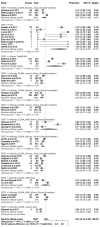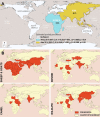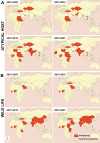Peste Des Petits Ruminants in Atypical Hosts and Wildlife: Systematic Review and Meta-Analysis of the Prevalence between 2001 and 2021
- PMID: 35546985
- PMCID: PMC9083865
- DOI: 10.22092/ari.2021.356900.1939
Peste Des Petits Ruminants in Atypical Hosts and Wildlife: Systematic Review and Meta-Analysis of the Prevalence between 2001 and 2021
Abstract
Peste des petits ruminants (PPR) or goat plague is considered a leading, highly contagious, and most lethal infectious viral disease of small ruminants affecting the worldwide livestock economy and international animal trade. Although sheep and goats are the primarily affected, the PPR Virus (PPRV) host range has expanded to other livestock (large ruminants) and wildlife animals over the last few decades, resulting in serious concern to the ongoing PPR global eradication program, which is primarily optimized, designed, and targeted towards accessible sheep and goat population. A systematic review and meta-analysis study was conducted to estimate the prevalence and spill-over infection of PPRV in large ruminants (bovine and camel) and wildlife. Published articles from 2001 to October 2021 on the "PPR" were searched in four electronic databases of PubMed, Scopus, Science direct, and Google Scholars. The articles were then selected using inclusion criteria (detection/prevalence of PPRV in bovine, camel, and wildlife population), exclusion criteria (only sheep or goats, lack of prevalence data, experimental trial, test evaluation, and reviews written in other languages or published before 2001), and the prevalence was estimated by random effect meta-analysis model. In the current study, all published articles belonged to Africa and Asia. The overall pooled prevalence of PPR estimates was 24% (95% CI: 15-33), with 30% in Asia (95% CI: 14-49) and 20% in Africa (95% CI: 11-30). The overall estimated pooled prevalence at an Africa-Asia level in bovine and camel was 13% (95% CI: 8-19), and in wildlife, it was 52% (95% CI: 30-74) with significant heterogeneity (I2 = 97%) in most pooled estimates with a high prevalence in atypical hosts and wildlife across Asia and Africa. Over the last two decades, the host range has increased drastically in the wildlife population, even for prevalent PPR in the unnatural hosts only for a short time, contributing to virus persistence in multi-host systems with an impact on PPR control and eradication program. This observation on the epidemiology of the PPRV in unnatural hosts demands appropriate intervention strategies, particularly at the livestock-wildlife interface.
Keywords: Bovine; Camel; Meta-analysis, Prevalence; PPR; Systemic Review; Wildlife.
Figures








Similar articles
-
Peste Des Petits Ruminants in Pawe District, Northwest Ethiopia: A Study on Seroprevalence and Associated Risk Factors.Vet Med Sci. 2025 Sep;11(5):e70489. doi: 10.1002/vms3.70489. Vet Med Sci. 2025. PMID: 40709454 Free PMC article.
-
Seroprevalence and risk factors of peste des petits ruminants in sheep and goats in the Savannah district, northern Ivory Coast.J Vet Sci. 2025 Jul;26(4):e53. doi: 10.4142/jvs.24312. J Vet Sci. 2025. PMID: 40765233 Free PMC article.
-
Mapping Small Ruminant Trade Networks in Ethiopia's Somali Region and Borena Zone: Implications for the Spread of Peste des Petits Ruminants Virus.Transbound Emerg Dis. 2025 Jul 13;2025:6620243. doi: 10.1155/tbed/6620243. eCollection 2025. Transbound Emerg Dis. 2025. PMID: 40692876 Free PMC article.
-
A Scoping Review on Progression Towards Freedom from Peste des Petits Ruminants (PPR) and the Role of the PPR Monitoring and Assessment Tool (PMAT).Viruses. 2025 Apr 14;17(4):563. doi: 10.3390/v17040563. Viruses. 2025. PMID: 40285005 Free PMC article.
-
Peste des petits ruminants (PPR) in Africa and Asia: A systematic review and meta-analysis of the prevalence in sheep and goats between 1969 and 2018.Vet Med Sci. 2020 Nov;6(4):813-833. doi: 10.1002/vms3.300. Epub 2020 Jun 12. Vet Med Sci. 2020. PMID: 32529792 Free PMC article.
Cited by
-
The evaluation of five serological assays in determining seroconversion to peste des petits ruminants virus in typical and atypical hosts.Sci Rep. 2023 Sep 8;13(1):14787. doi: 10.1038/s41598-023-41630-3. Sci Rep. 2023. PMID: 37684280 Free PMC article.
-
Structure, Attachment and Transmembrane Internalisation of Peste Des Petits Ruminants Virus.Vet Med Sci. 2025 Jan;11(1):e70182. doi: 10.1002/vms3.70182. Vet Med Sci. 2025. PMID: 39739994 Free PMC article. Review.
-
Development and characterization of a novel nanobody with SRMV neutralizing activity.Microb Cell Fact. 2024 Feb 10;23(1):45. doi: 10.1186/s12934-024-02311-6. Microb Cell Fact. 2024. PMID: 38341572 Free PMC article.
-
Synonymous codon usage influences the transmission of peste des petits ruminants (PPR) virus in camels.Vet Res Commun. 2024 Dec;48(6):4043-4049. doi: 10.1007/s11259-024-10503-z. Epub 2024 Aug 21. Vet Res Commun. 2024. PMID: 39167257
-
A Clinical, Pathological, Epidemiological and Molecular Investigation of Recent Outbreaks of Peste des Petits Ruminants Virus in Domestic and Wild Small Ruminants in the Abu Dhabi Emirate, United Arab Emirates.Vet Sci. 2023 Jan 13;10(1):56. doi: 10.3390/vetsci10010056. Vet Sci. 2023. PMID: 36669056 Free PMC article.
References
-
- FAO. Supporting Livelihoods and Building Resilience through Peste des Petits Ruminants (PPR) and Small Ruminant Diseases Control Rome: Animal Production and Health Position Paper; 2013. Available from: http://www.fao.org/ppr/en/
-
- Balamurugan V, Krishnamoorthy P, Veeregowda BM, Sen A, Rajak KK, Bhanuprakash V, et al. Seroprevalence of Peste des petits ruminants in cattle and buffaloes from Southern Peninsular India. Trop Anim Health Prod. 2012;44(2):301–6. - PubMed
-
- Fakri FZ, Bamouh Z, Jazouli M, Omari Tadlaoui K, Elharrak M. Experimental infection of dromedary camels with virulent virus of Peste des Petits Ruminants. Vet Microbiol. 2019;235:195–8. - PubMed
-
- Govindarajan R, Koteeswaran A, Venugopalan AT, Shyam G, Shaouna S, Shaila MS, et al. Isolation of pestes des petits ruminants virus from an outbreak in Indian buffalo (Bubalus bubalis) Vet Rec. 1997;141(22):573–4. - PubMed
Publication types
MeSH terms
LinkOut - more resources
Full Text Sources
